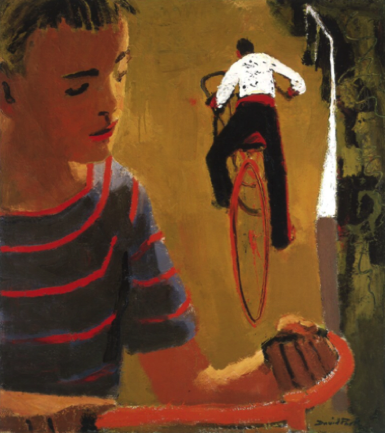
California Dreaming,
The San Francisco Bay Area Movement
Talking Arts Series with Cliff Tisdell
The Bay Area art scene during the 1950s and 1960s represents a compelling chapter in American art history. Following World War II, the dominant New York School of painting held to a dictum of pure abstraction. Few were willing to risk their careers by including subject matter in paintings.
However in 1950, David Park, a painting instructor at Cal Arts, shocked his colleagues when he suddenly started to include the figure in his paintings. His Kids on Bikes (image above) blended abstract-expressionism with figurative art creating a new look in modern painting.
Influenced by Park, colleagues Elmer Bischoff and Richard Diebenkorn began to include the figure and elements of landscape in their work. Bischoff’s paintings renew a connection to Edward Hopper with urban scenes, including theatre lobbies and isolated figures in interiors. Bischoff dared to paint landscapes and seascapes that reject cool detachment for a romantic sensibility.
Diebenkorn, painted Horse and Rider in 1954 marking his first attempt to return to elements of the figure, but initially was afraid to show it. The painting would go on to become a key example of a return to representation. Of the three painters, Diebenkorn would remain committed to include formal abstraction with elements of landscape, as demonstrated in his best known work, the Ocean Park series.
Encouraged by Park and Bischoff, student Joan Brown initially worked in thickly painted semi-abstract paintings incorporating the figure and elements from the natural world. Effected by the beats and counter-culture of the 1960s, she went on to develop Funk art. Often whimsical, colorful, large-format paintings and constructions focus on personal narratives including people and scenes from her everyday life, pets, dancing, and a love for swimming.
Viola Frey, from a farming family in the Napa Valley region, studied with Diebenkorn in 1956. Creating non-functional ceramics influenced by California Funk she was largely ignored, until her human-scale Mrs. National Geographic based on her grandmother, was purchased by the Met in 1978. Now she is known primarily for her amazing larger-than-life ceramic figures.
These California artists were bold enough to follow their passions, even though it went against art trends and the weight of abstract expressionism. Their work anticipated the post-movement art world of today.
cliff tisdell
may 15, 2023
© cliff tisdell, 2023. any usage of this article requires written consent